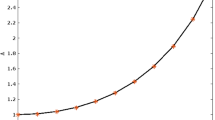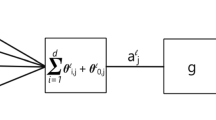Based on radial basis functions approximation, we develop in this paper a new com-putational algorithm for numerical differentiation. Under an a priori and an a posteriori choice rules for the regularization parameter, we also give a proof on the convergence error estimate in reconstructing the unknown partial derivatives from scattered noisy data in multi-dimension. Numerical examples verify that the proposed regularization strategy with the a posteriori choice rule is effective and stable to solve the numerical differential problem.
Similar content being viewed by others
References
R.A. Adams, Sobolev Spaces (Academic Press [A subsidiary of Harcourt Brace Jovanovich], New York–London, 1975). Pure and Applied Mathematics, Vol. 65.
R.S. Anderssen and M. Hegland, For numerical differentiation, dimensionality can be a blessing! Math. Comput. 68(227) (1999) 1121–1141.
J. Cheng, Y.C. Hon and Y.B. Wang, A numerical method for the discontinuous solutions of Abel integral equations, in: Inverse Problems and Spectral Theory, volume 348 of Contemp. Math., pp. 233–243. Am. Math. Soc., Providence, Rhode Island, 2004.
J. Cullum, Numerical differentiation and regularization, SIAM J. Numer. Anal. 8 (1971) 254–265.
S.R. Deans, The Radon Transform and Some of its Applications, A Wiley-Interscience Publication (Wiley, New York, 1983).
J. Duchon, Splines minimizing rotation-invariant semi-norms in Sobolev spaces, in: Constructive Theory of Functions of Several Variables (Proc. Conf., Math. Res. Inst., Oberwolfach, 1976), Lecture Notes in Math., Vol. 571. (Springer, Berlin Heidelberg New York, 1977) pp. 85–100.
J. Duchon, Sur l'erreur d'interpolation des fonctions de plusieurs variables par les D m-splines. RAIRO Anal. Numér. 12(4) (1978) 325–334, vi.
R. Gorenflo and S. Vessella, Abel Integral Equations, volume 1461 of Lecture Notes in Mathematics (Springer, Berlin Heidelberg New York, 1991), Analysis and applications.
C.W. Groetsch, Differentiation of approximately specified functions, Am. Math. Mon. 98(9) (1991) 847–850
M. Hanke and O. Scherzer, Error analysis of an equation error method for the identification of the diffusion coefficient in a quasi-linear parabolic differential equation, SIAM J. Appl. Math. 59(3) (1999) 1012–1027 (electronic).
M. Hanke and O. Scherzer, Inverse problems light: numerical differentiation, Am. Math. Mon. 108(6) (2001) 512–521.
F.J. Hickernell and Y.C. Hon, Radial basis function approximations as smoothing splines, Appl. Math. Comput. 102(1) (1999) 1–24.
W. Light and H. Wayne, On power functions and error estimates for radial basis function interpolation, J. Approx. Theory 92(2) (1998) 245–266.
L.T. Luh, The embedding theory of native spaces, Approx. Theory its Appl. (N.S.) 17(4) (2001) 90–104.
W.R. Madych and S.A. Nelson, Multivariate interpolation and conditionally positive definite functions. II, Math. Comput. 54(189) (1990) 211–230.
M.J.D. Powell, The uniform convergence of thin plate spline interpolation in two dimensions, Numer. Math. 68(1) (1994) 107–128.
A.G. Ramm and A.B. Smirnova, On stable numerical differentiation, Math. Comput. 70(235) (2001) 1131–1153 (electronic).
R. Schaback, Improved error bounds for scattered data interpolation by radial basis functions, Math. Comput. 68(225) (1999) 201–216.
A.N. Tikhonov and V.Y. Arsenin, Solutions of Ill-posed Problems, (V. H. Winston & Sons, Washington, District of Columbia: Wiley, New York, 1977). Translated from the Russian, Preface by translation editor Fritz John, Scripta Series in Mathematics.
G. Wahba and J. Wendelberger, Some new mathematical methods for variational objective analysis using splines and cross validation, Mon. Weather Rev. 108 (1980) 1122–1143.
Y.B. Wang, X.Z. Jia and J. Cheng, A numerical differentiation method and its application to reconstruction of discontinuity, Inverse Problems 18(6) (2002) 1461–1476.
Z.M. Wu and R. Schaback, Local error estimates for radial basis function interpolation of scattered data, IMA J. Numer. Anal. 13(1) (1993) 13–27.
J. Yoon, L p -error estimates for “shifted” surface spline interpolation on Sobolev space, Math. Comput. 72(243) (2003) 1349–1367 (electronic).
J. Yoon, On the stationary L p -approximation power to derivatives by radial basis function interpolation, Appl. Math. Comput. 150(3) (2004) 875–887.
Author information
Authors and Affiliations
Corresponding author
Additional information
Communicated by Joe Ward
*The work described in this paper was partially supported by a grant from CityU (Project No. 7001646) and partially supported by the National Natural Science Foundation of China (No. 10571079).
Rights and permissions
About this article
Cite this article
Wei, T., Hon, Y.C. Numerical differentiation by radial basis functions approximation. Adv Comput Math 27, 247–272 (2007). https://doi.org/10.1007/s10444-005-9001-0
Received:
Accepted:
Published:
Issue Date:
DOI: https://doi.org/10.1007/s10444-005-9001-0




